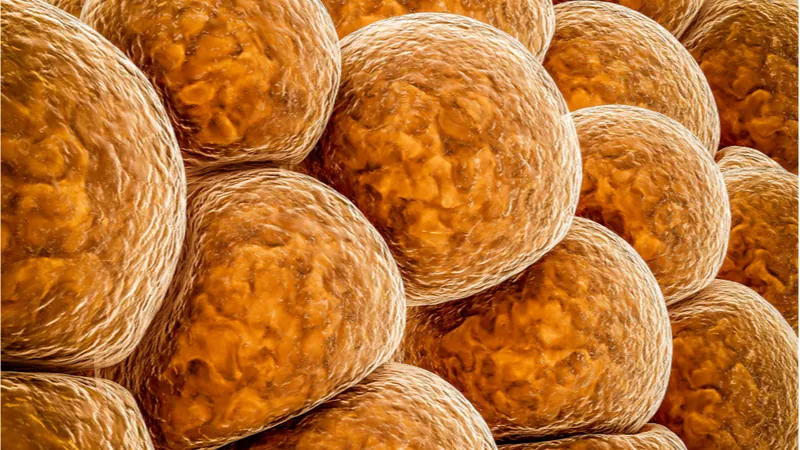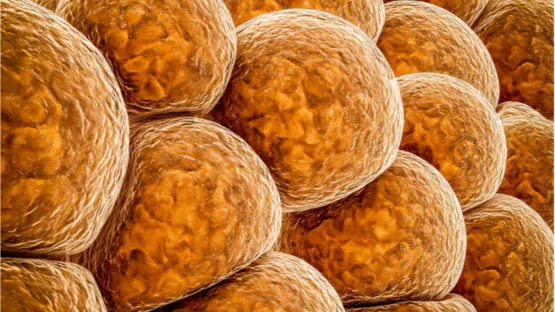A group of researchers has used CRISPR to create energy-dissipating brown adipocytes (fat cells) from white preadipocytes. The new cells were then shown to alleviate obesity in mice [1].
Obesity: the nemesis of longevity
Obesity is one of humanity’s deadliest enemies. It is a known comorbidity in a plethora of diseases, including age-related, such as cardiovascular diseases and diabetes. What WHO calls the obesity epidemic is one of the reasons why life expectancy, which had been on the rise for decades, has plateaued worldwide and is declining in the US. Recently, obesity made headlines as a condition that greatly exacerbates the effects of COVID-19. Obesity is so strongly correlated with many processes of aging, such as telomere shortening and inflammation [2], that one recent meta-study argues that obesity should be considered premature aging [3]. Another one suggests that obesity may actually accelerate aging [4].
WAT to store, BAT to burn
Obesity is simply too much fat, but there are two vastly different kinds of fat tissue in our bodies. The first type, called white adipose tissue (WAT), is the one that stores fat and is associated with obesity. The other one, brown adipose tissue (BAT), is used for burning rather than storing energy. BAT is present in the body in much smaller quantities, in visceral rather than superficial regions. BAT helps keep body temperature constant by generating heat in response to cold exposure. The mechanism behind this process involves UCP1 (uncoupling protein 1), which is probably BAT’s main hallmark. UCP1 interacts with the electron transport chain (ETC), the principal cellular mechanism of energy production. Normally, ETC produces adenosine triphosphate (ATP), the “energy currency” that powers most cellular processes. UCP1 modifies ETC so that it begins to generate heat instead of ATP. In other words, brown adipocytes use their fat reserves to produce thermal energy. BAT is the fat that burns fat.
Since activation of BAT increases energy expenditure and is inversely correlated with body mass index (BMI), BAT has become a potential target for anti-obesity therapies. However, recruiting BAT to the war against obesity is easier said than done: as of now, scientists have failed to produce methods that would considerably increase BAT activation or volume, with cold exposure remaining the only viable strategy [5]. In the current study, the scientists tried a different approach: transplantation of genetically engineered BAT-like cells.
Turning white to brown
Since brown fat is scarce, the scientists searched for ways to obtain brown adipocytes or the next best thing from a more abundant source. Using CRISPR technology, they inserted UCP1-producing genes into human white preadipocytes (adipocyte precursor cells). The treated cells then differentiated into human brown-like (HUMBLE) cells. The new cells demonstrated several BAT-like properties, the most important of which was high levels of UCP1, almost on par with their brown cousins. HUMBLE cells were then transplanted into mice, with two control groups receiving white adipocytes and bona fide brown adipocytes from the same individuals. The transplanted HUMBLE cells continued to churn out UCP1 during the whole period of study (12 weeks). Moreover, the surrounding tissue became vascularized and innervated, just like “real” BAT, which requires sprawling vasculature for heat dissipation (the task that HUMBLEs were found to successfully perform). The detected secretion of adipokines – fat-specific cytokines – led the researchers to believe that the transplants had evolved into fully functional fat tissue.
HUMBLEs alleviate obesity
Next, the researchers wanted to determine whether HUMBLE cells can prevent metabolic disorders in mice suffering from diet-induced obesity (DIO). As it turned out, mice fed a high-fat diet gained less fat if they received HUMBLE cells or “true” brown adipocytes as opposed to white adipocytes. These mice also showed significant improvements in glucose tolerance and insulin sensitivity compared to the white adipocyte control group, consumed more oxygen, and generated more heat even though the food intake remained the same. While the glucose tolerance in the “white” control group deteriorated over time, mice that received HUMBLEs continued to show greatly improved tolerance as late as 12 weeks after the transplantation. HUMBLE transplantation also resulted in the decline in liver lipid content (less fatty livers). The results were then largely recreated in mice that became obese well before the transplantation. The researchers take this as a sign that BAT transplantation can potentially be used to treat as well as prevent obesity.
One of the most interesting and promising findings was that HUMBLEs and brown control cells seemed to increase the activity of endogenous (originally present) BAT in the mice. The researchers determined that the transplanted cells activated murine BAT via nitric acid signaling, amplifying glucose uptake and energy expenditure. The ability of transplanted cells to recruit allies among the endogenous brown adipocyte population makes BAT transplantation therapy even more plausible.
Conclusion
This study further explores the fundamental difference between white and brown fat tissue and offers a strategy of harnessing the energy-dissipating power of BAT against the obesity epidemic. Despite the results being promising, it remains to be seen whether BAT transplantation benefits can be safely recreated in humans.
Literature
[1] Wang, C. H., Lundh, M., Fu, A., Kriszt, R., Huang, T. L., Lynes, M. D., … & Narain, N. R. (2020). CRISPR-engineered human brown-like adipocytes prevent diet-induced obesity and ameliorate metabolic syndrome in mice. Science Translational Medicine, 12(558).
[2] Ahima, R. S. (2009). Connecting obesity, aging and diabetes. Nature medicine, 15(9), 996-997.
[3] Tam, B. T., Morais, J. A., & Santosa, S. (2020). Obesity and ageing: Two sides of the same coin. Obesity Reviews, 21(4), e12991.
[4] Salvestrini, V., Sell, C., & Lorenzini, A. (2019). Obesity may accelerate the aging process. Frontiers in endocrinology, 10, 266.
[5] Fenzl, A., & Kiefer, F. W. (2014). Brown adipose tissue and thermogenesis. Hormone molecular biology and clinical investigation, 19(1), 25-37.




